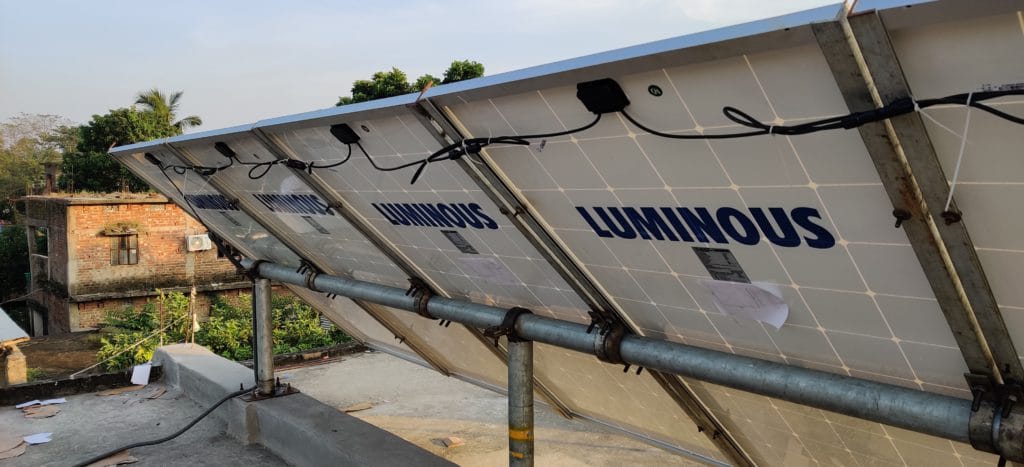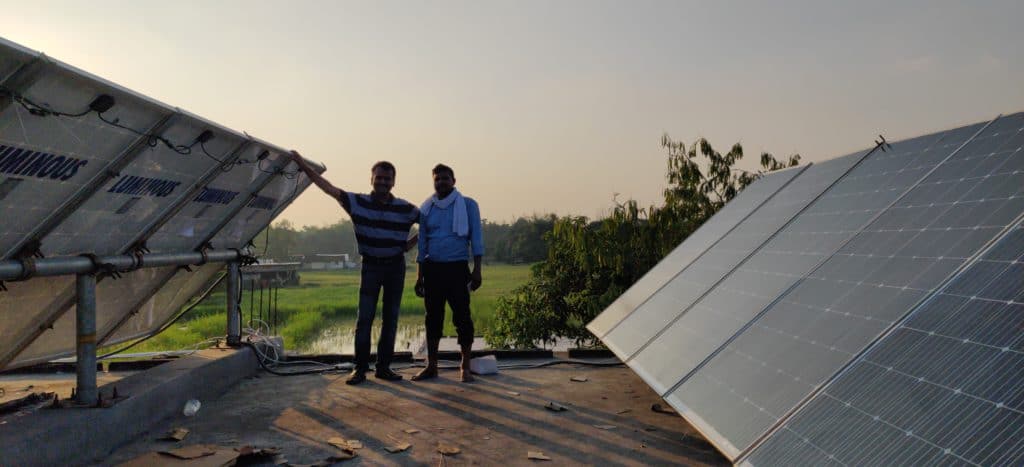With advancement in technology, power generation per unit area of a solar plant is improving continuously. While solar panels have improved from poly-crystalline to mono-crystalline to bifacial variants, the inverters have improved the solar extraction capability with use of MPPT technology. The mounting structures too play a significant role in improving the solar power generation efficiency of a plant – in some cases up to 40%.
There are two broad categories of mounting structures for solar panels:
1. Fixed Systems
2. Sun Tracking System
Fixed System
These systems are typically inclined at an angle equal to latitude of the installation location and are oriented at true south direction.
Seasonal Variation
Sunray, broadly speaking, hits ground at an angle equal to latitude of the place. So, if panels are inclined at the same angle, the rays would now be incident at an angle of 90 degrees. Maximum photoelectric generation happens when the rays are incident on the panels at an angle of 90 degrees. However, position of sun (rise) is not fixed round the year. During winters, the sun “goes down” a bit and reverse happens during summers. This is more pronounced as we move away from equator (at equator, Sun is directly above head and follows east to west movement, all year-round). So, for fixed systems, as Sun’s angle of incidence changes (with season), the fixed orientation does not always intercept the rays at right angle and hence the generation is not always the maximum possible value.
Daily Variation
As Sun moves from east to west, the rays hit the panel at right angle at noon and for remaining times ,strikes the surface at a different angle. So fixed angle structures, are not able to ensure that Sun rays always hit it perpendicularly (across the E-W surface). Hence the maximum generation through the day is not achieved.
Sun Track System
Sun Track Systems try to address the issues above by its ability to change angle – around either or both the axes (horizonal E-W axis vertical axis). The systems that allow changes along horizontal -E-W angle is called single Axis System. While the ones that allow movement along both vertical and horizontal E-W angle is called dual Axis System). Further categorization in either of these groups is based on the fact if this movement is to be done manually or automatically.
Single Axis System
These systems allows the panels to move around horizontal axis (E-W). These adjusts the angle as Sun’s rise change with year.
Single Axis Manual Systems
These systems allows adjustment through manual movement of the system. Typically, one would adjust the angle once in a quarter.
Single Axis Automatic Systems
As the name indicates, such systems do not need any manual intervention. The system auto adjusts angles as per the Sun’s rise. Such systems are obviously most efficient. But these have many moving parts and logic inbuilt – as such the costs of such structure are pretty high and these are also liable to more breakdowns thus leading to more maintenance cost and more frequent disruptions.
Dual Axis Systems
These systems allows panels to rotate around horizontal as well vertical axis. Thus such structures can follow daily movement of Sun from East to West as well as seasonal movements. These structures have the maximum efficiency (around 40-50%). However, these are also the most expensive of the lot. These are further sub-divided into two types:
Dual Axis Manual System
These structure allow for adjustments along the two axes via manual movement. However, it does not make much sense for someone to adjust orientation manually through the day.
Dual Axis Automatic Systems
These are the default choice for Dual Axis Systems. These are most efficient of the lot but also have lot many moving parts and hence are much more costlier. These also incur more maintenance cost and are likely to have a few disruptions due to breakdown.
Which one should you choose
This depends on few factors:
1. How far away you are from latitude: if you are near equator, Sun’s rise is fixed around the year. As you move away, the angle of rise changes with season. So, if you are situated away from equator, Sun Track system should benefit you more and vice versa.
2. Project cost: Sun Track systems are more expensive than fixed ones. Of the two Sun track systems, dual axis is more expensive than the single axis ones. Again in either of these categories, the automatic systems are more expensive than the manual ones.
3. Space availability: With reduction in price of solar panels, loss of efficiency due to fixed structure can be more than compensated by adding few more panels, if we have ample space available.
So, decision to use fixed/sun-track system needs to be taken based on factors stated above and varies from project to project – there is no silver bullet to opt for one over the other.
Dabun Solar’s experience on usage of Sun Track System
Dabun installed a 5 KWT Solar generating set in India (Bihar). The requirement from the customer was to design a plant that was the most efficient and still pocket friendly. Among the other things, the choice of structures was discussed. Dual Axis automatic system was way too expensive, had more maintenance cost and was more prone to breakdowns. Single Axis System with manual variant seemed to be a good fit – the design almost matched the cost of fixed structure. There weren’t lot many moving parts either – so maintenance was not high (quarterly adjustment was included in scope of Operation and Maintenance without much increase in cost). The efficiency improvement was noted at 15% over the fixed variant.
 Rear View – Single Axis Manual Tracker
Rear View – Single Axis Manual Tracker



